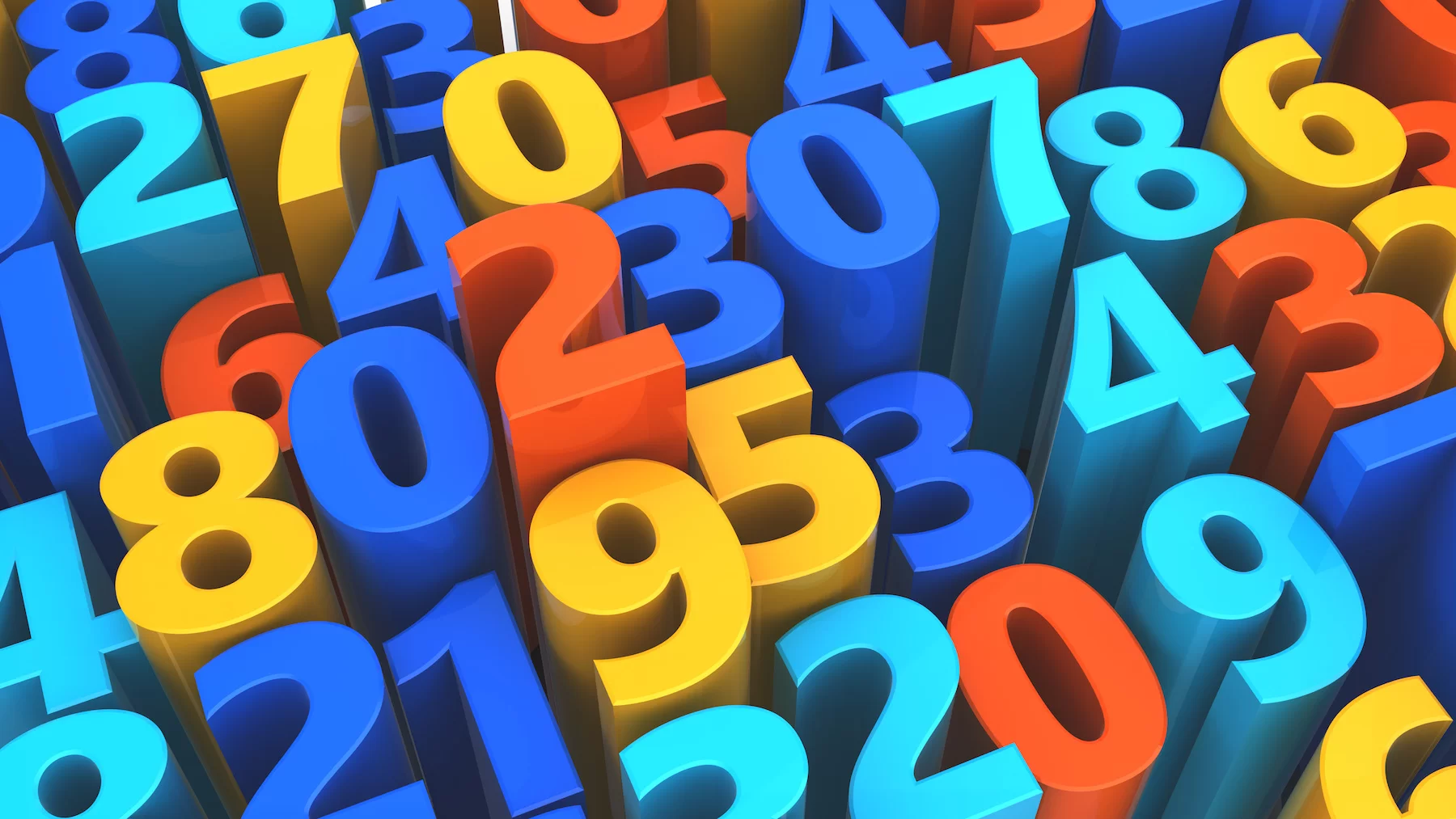Discover how to count and read numbers in English. Delve into various types of numbers and explore basic math expressions in English.Numbers play a crucial role not only in the realm of mathematics but also in the English language, serving to quantify, measure, and convey numerical information. In our daily lives, we rely on numbers for various purposes, such as in calendars, to-do lists, recipes, and when denoting ages.
In this guide, we will explore numbers in English, their usage, and practical applications.
What is your English level?
Find out your A1 A2 B1 B2 C1 C2 level of English with our online test and receive your English certificate.
Counting basics
The number sequence from 1 to 10
The basis of understanding numbers lies in counting. To begin, let’s go over the English spellings of numbers 1 to 10.
| umbers | English spelling | Pronunciation |
| 1 | One | /wuhn/ |
| 2 | Two | /too/ |
| 3 | Three | /three/ |
| 4 | Four | /fohr/ |
| 5 | Five | /faɪv/ |
| 6 | Six | /sihks/ |
| 7 | Seven | /SEH-vihn/ |
| 8 | Eight | /ayt/ |
| 9 | Nine | /naɪn/ |
| 10 | Ten | /tehn/ |
Counting in multiples
In the field of mathematics, a multiple is the result obtained by multiplying one number by another. For instance, if you multiply 5 by 6, the product is 30. In this scenario, 30 is considered a multiple of both 5 and 6.
Other multiples of five are:
10, 15, 20, 25, 30, 35, etc.
Other multiples of six are:
12, 18, 24, 30, 36, 43, etc.
Multiples of 10 are:
10, 20, 30, 40, 50, 60, 70, 80, 90, 100, etc.
Cardinal numbers
Understanding cardinal numbers and their usage
Cardinal numbers are commonly employed for counting and indicating quantities. They are frequently utilized for:
- Give your age in years: “I’m 26 years old.”
- Give your telephone number: “My phone number is five-five-five-six-four-three-two.”
When writing in English, it’s best to spell out cardinal numbers one to nine. For example:
- “I have five siblings.”
- “I bought four books for my brother.”
Meanwhile, the Chicago Manual of Style suggests using numerals to express large numbers (10 and above). For example:
- “There are 11 students in the class.”
- “About 101 people signed up for the training.”
Counting beyond 10:
Numbers from 11 to 20 often have unique names and patterns. They are:
- 11 – Eleven – /ih-LEV-uhn/
- 12 – Twelve – /twehl-VE/
- 13 – Thirteen – /thr-TEEN/
- 14 – Fourteen – /fohr-TEEN/
- 15 – Fifteen – /fihf-TEEN/
- 16 – Sixteen – /siks-TEEN/
- 17 – Seventeen – /seh-vihn-TEEN/
- 18 – Eighteen – /ayt-TEEN/
- 19 – Nineteen – /nain-TEEN/
- 20 – Twenty – /TWEN-tee/
- 21 – Twenty-one – /twehn-tee-WUHN/
- 22 – Twenty-two – /twehn-tee-TOO/
- 23 – Twenty-three – /twehn-tee-THREE/
- 24 – Twenty-four – /twehn-tee-FOHR/
- 25 – Twenty-five – /twehn-tee-FAIV/
- 26 – Twenty-six – /twehn-tee-SIKS/
- 27 – Twenty-seven – /twehn-tee-SEH-vihn/
- 28 – Twenty-eight – /twehn-tee-AYT/
- 29 – Twenty-nine – /twehn-tee-NAIN/
- 30 – Thirty – /THR-tee/
- 40 – Forty – /FOHR-tee/
- 50 – Fifty – /FIF-tee/
- 60 – Sixty – /SIKS-tee/
- 70 – Seventy – /SEV-vihn/tee/
- 80 – Eighty – /AY-tee/
- 90 – Ninety – /NAIN-tee/
- 100 – One hundred or hundred – /wuhn-HUN-druhd/
Counting in hundreds and thousands
Having learned how to count from one to 100 in English, let’s now delve into counting larger quantities in hundreds and thousands. Below is a compilation of numbers in hundreds and thousands, accompanied by their English spellings:
| Hundreds | English spelling | Pronunciation |
| 100 | One hundred | /wuhn-HUN-druhd/ |
| 200 | Two hundred | /too-HUN-druhd/ |
| 300 | Three hundred | /three-HUN-druhd/ |
| 400 | Four hundred | /fohr-HUN-druhd/ |
| 500 | Five hundred | /faiv-HUN-druhd/ |
| 600 | Six hundred | /siks-HUN-druhd/ |
| 700 | Seven hundred | /seh-vihn-HUN-druhd/ |
| 800 | Eight hundred | /ayt-HUN-druhd/ |
| 900 | Nine hundred | /nain-HUN-druhd/ |
| Thousands | English spelling | |
| 1,000 | One thousand | /wuhn-THAU-zend/ |
| 2,000 | Two thousand | /too-THAU-zend/ |
| 3,000 | Three thousand | /three-THAU-zend/ |
| 4,000 | Four thousand | /fohr-THAU-zend/ |
| 5,000 | Five thousand | /faiv-THAU-zend/ |
| 6,000 | Six thousand | /siks-THAU-zend/ |
| 7,000 | Seven thousand | /seh-vinh-THAU-zend/ |
| 8,000 | Eight thousand | /ayt-THAU-zend/ |
| 9,000 | Nine thousand | /nain-THAU-zend/ |
Now, continuing with the pattern:
| 10,000 | Ten thousand | /tehn-THAU-zend/ |
| 11,000 | Eleven thousand | /ih-LEH-uhn-THAU-zend/ |
| 12,000 | Twelve thousand | /twehl-ve-THAU-zend/ |
| 13,000 | Thirteen thousand | /thr-teen-THAU-zend/ |
| 14,000 | Fourteen thousand | /fohr-teen-THAU-zend/ |
| 15,000 | Fifteen thousand | /fihf-teen-THAU-zend/ |
| 16,000 | Sixteen thousand | /siks-teen-THAU-zend/ |
| 17,000 | Seventeen thousand | /seh-vihn-teen-THAU-zend/ |
| 18,000 | Eighteen thousand | /ayt-teen-THAU-zend/ |
| 19,000 | Nineteen thousand | /nain-teen-THAU-zend/ |
| 20,000 | Twenty thousand | /twen-tee-THAU-zend/ |
| 30,000 | Thirty thousand | /thr-tee-THAU-zend/ |
| 40,000 | Forty thousand | /fohr-tee-THAU-zend/ |
| 50,000 | Fifty thousand | /fif-tee-THAU-zend/ |
| 60,000 | Sixty thousand | /siks-tee-THAU-zend/ |
| 70,000 | Seventy thousand | /seh-vihn-tee-THAU-zend/ |
| 80,000 | Eighty thousand | /ayt-tee-THAU-zend/ |
| 90,000 | Ninety thousand | /nain-tee-THAU-zend/ |
| 100,000 | One hundred thousand | /wuhn-hun-druhd-THAU-zend/ |
Are you C1 Advanced English?
Get your C1 Advanced English certificate now!
✓ Add your certificate to your resume
⭐ ⭐ ⭐ ⭐ ⭐
Ordinal numbers
Definition and usage of ordinal numbers
Ordinal numbers in English indicate order and rank. They are commonly formed by adding “th” at the end of a cardinal number. These numbers are employed when you wish to:
- Give a date in the calendar: “My birthday is on the 26th of next month.”
- Put things in order: “He is the fifth on the list.”
- Refer to centuries: “The museum was established in the 18th century.”
- Refer to a floor of a building: “My office is on the 10th floor.”
Forming ordinal numbers from cardinal numbers
As mentioned above, we form most ordinal numbers by adding the suffix “th” to cardinal numbers. Here is a list of ordinal numbers:
- 1st – First
- 2nd – Second
- 3rd – Third
- 4th – Fourth
- 5th – Fifth
- 6th – Sixth
- 7th – Seventh
- 8th – Eighth
- 9th – Ninth
- 10th – Tenth
- 11th – Eleventh
- 12th – Twelfth
- 13th – Thirteenth
- 14th – Fourteenth
- 15th – Fifteenth
- 16th – Sixteenth
- 17th – Seventeenth
- 18th – Eighteenth
- 19th – Nineteenth
- 20th – Twentieth
- 21st – Twenty-first
- 22nd – Twenty-second
- 23rd – Twenty-third
- 30th – Thirtieth
- 40th – Fortieth
- 50th – Fiftieth
- 60th – Sixtieth
- 70th – Seventieth
- 80th – Eightieth
- 90th – Ninetieth
- 100th – Hundredth
When writing out large numbers in ordinals, we change the last numeral to an ordinal number. For example:
- 104th – One hundred fourth
- 287 – Two hundred eighty-seventh

Fractions and decimals
Introduction to fractions and decimals
Fractions and decimals enable accurate representation of values and proportions. These fundamental concepts depict portions of a whole or values between whole numbers, essentially representing fractional or decimal numbers.
Common fractions and their representation
Fractions are comprised of two components: a numerator and a denominator, separated by a slash (/). The numerator signifies the number of parts we possess, while the denominator indicates the total number of equal parts constituting the whole.
For instance, in the fraction 3/4, the numerator is three, signifying three parts, and the denominator is four, representing that the whole is divided into four equal parts.
Now, let’s examine common fractions and the correct way to express them in English:
| Common fractions | English name |
| 1/2 | One half |
| 1/3 | One third |
| 1/4 | One quarter |
| 2/3 | Two thirds |
| 3/5 | Three fifths |
Note: When reading fractions, we use the cardinal number as the numerator and the ordinal number as the denominator.
Decimal numbers and their usage
Decimal numbers play a significant role in everyday life, particularly when it comes to money, measurements, and scientific calculations. Decimal numbers aren’t whole, and they have a decimal point (.) like in 0.002, 0.03, and 0.95.
Decimal numbers are pronounced by listing each digit. Examples are:
- 0.1201: Zero point one two zero one, or point one two zero one
- 7.5: Seven point five
For clarity, it is best to write decimal numbers as numerals. Let’s look at some examples:
- “The tomatoes I bought weigh 74.5 grams.”

Large numbers
Considerable figures, such as millions, billions, and trillions, arise in diverse contexts, such as finance and economics, where they represent national debt, GDP, or corporate revenues. Additionally, in population statistics, they are employed to denote the number of individuals.
Large numbers are formed by adding specific suffixes to the base numbers. Let’s look at some examples:
- Million (six zeros): 1,000,000 (one million)
- Billion (nine zeros): 1,000,000,000 (one billion)
- Trillion (12 zeros): 1,000,000,000,000 (one trillion)
- Quadrillion (15 zeros): 1,000,000,000,000,000 (one quadrillion)
- Quintillion (18 zeros): 1,000,000,000,000,000,000 (one quintillion)
What is your English level?
Find out your A1 A2 B1 B2 C1 C2 level of English with our online test and receive your English certificate.
144Mathematical expressions
The fundamental mathematical operations include addition, subtraction, multiplication, and division. We will delve into the definitions of these operations and their application in English.
Addition
Addition involves merging two or more numbers to determine their cumulative sum. In English, we denote addition using the term “plus” or the symbol “+”.
Examples:
- 3 + 5 = 8
- English expression: Three plus five equals eight.
- 12 + 20 = 32
- English expression: Twelve plus twenty equals thirty-two.
Subtraction
Subtraction is the process of finding the difference between two numbers. In English, we express subtraction using the word “minus” or the “-” symbol.
Examples:
- 10 – 4 = 6
- English expression: Ten minus four equals six.
- 25 – 15 = 10
- English expression: Twenty-five minus fifteen equals ten.
Multiplication
Multiplication is the process of repeated addition. In English, we express multiplication using the word “multiply” and “times” or the “×” symbol.
Examples:
- 2 × 2 = 4
- English expression: Two multiplied by three equals four.
- 5 × 2 = 10
- English expression: Five times four equals ten.
Division
Division is the act of distributing a quantity evenly into multiple parts. In English, we convey division using the word “divide” or the symbol “÷”.
Examples:
- 12 ÷ 4 = 3
- English expression: Twelve divided by three equals three.
- 30 ÷ 6 = 5
- English expression: Thirty divided by six equals five.

Conclusion
In summary, gaining proficiency in numbers in English is essential for successful communication and problem-solving, whether in routine daily exchanges or more intricate professional situations. The encouraging aspect is that you likely already know most of the rules outlined here, as numbers are a part of our everyday language. Therefore, by engaging in regular practice and immersing yourself in the realm of numbers, you can leverage the power of mathematics in your daily life.
What is your English level?
Find out your A1 A2 B1 B2 C1 C2 level of English with our online test and receive your English certificate.
I am Nilay, an experienced English Language Assessment Director at the International English Test, where I have been working full-time since February 2020. I specialize in helping people worldwide validate their English proficiency through comprehensive assessments and certifications.
Before joining the International English Test, I worked as a self-employed English Language Assessment Consultant from January 2015 to December 2019. During this time, I assisted companies and individuals in improving their language skills, helping them achieve their academic and professional goals.
I hold a degree in Engineering and have also studied at Shafston International College in Australia. My educational background has equipped me with the tools to make a meaningful impact in the field of English language learning. Additionally, I enjoy sharing my expertise through articles that explore effective teaching methods and language assessment strategies, contributing to the International English Test and the broader assessment community.





